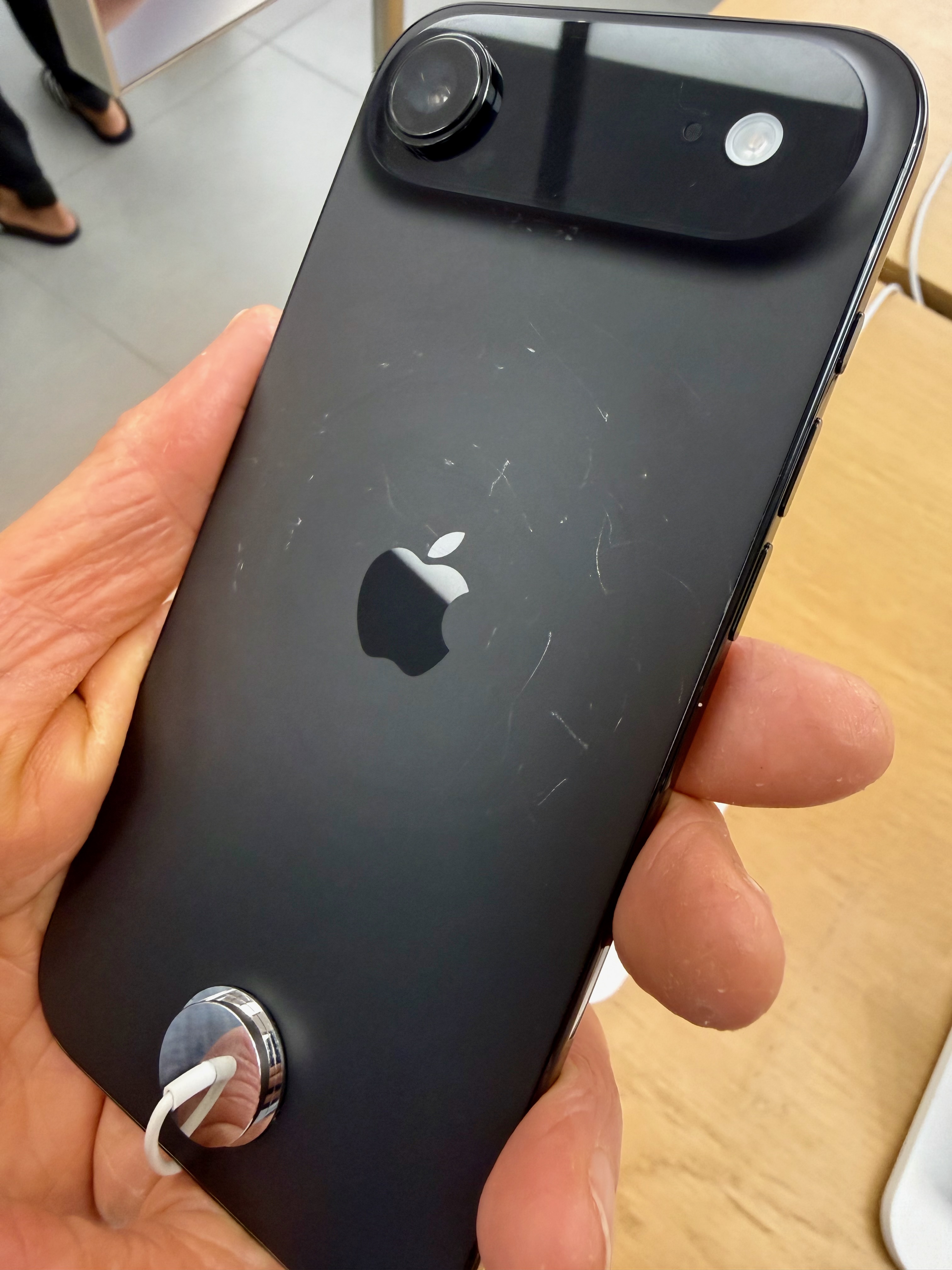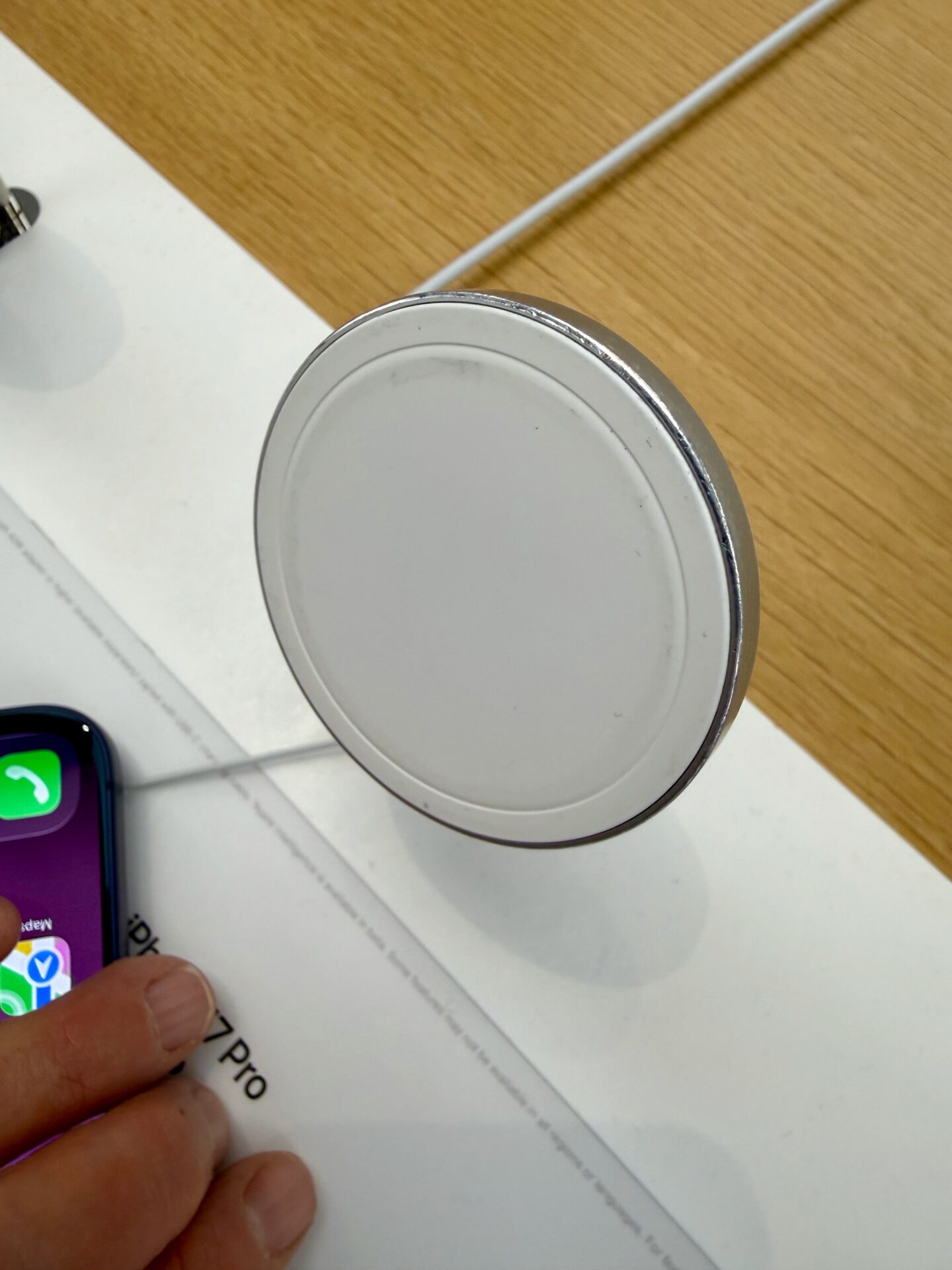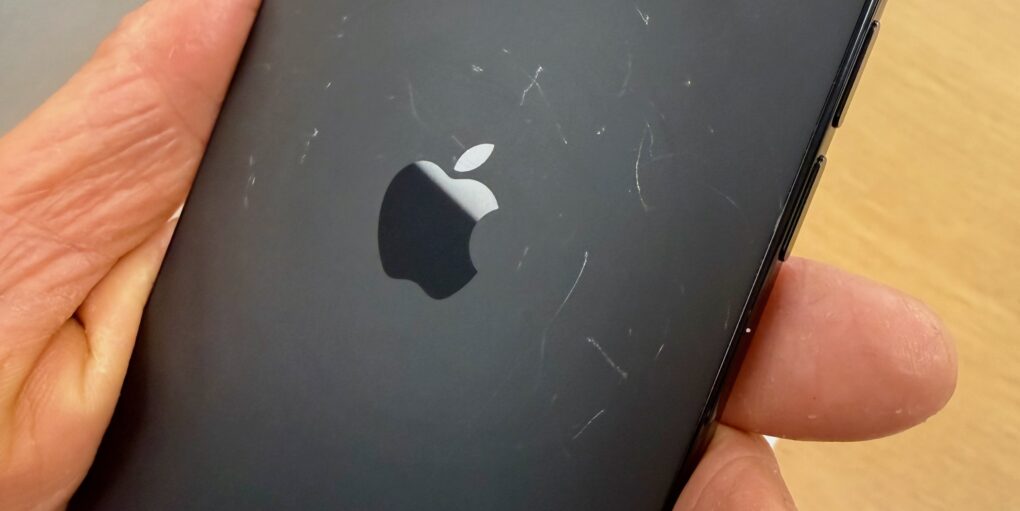SAN FRANCISCO — The iPhone 17 Scratchgate drama is real. Demo units of the new iPhone 17 Pro and iPhone Air models in Apple retail stores are showing scratches on opening weekend. The scratches appeared on their aluminum frames and on the glass panels on their backs.
I examined demo iPhones at Apple Stonestown in San Francisco on Friday (the busy iPhone 17 launch day) and again on Sunday. Many of the new iPhone 17 Pros and iPhone Airs are already scratched, especially the iPhone 17 Pro in deep blue and the iPhone Air in space black. But other colors showed scratches, too, even the iPhone 17 Pro in cosmic orange — the hot color this year.
iPhone 17 scratches: Scratchgate is back

Photo: Leander Kahney/Cult of Mac
The launch of new iPhones is almost always quickly followed by some “-gate” controversy. Previous post-launch problems include the iPhone 4’s Antennagate, iPhone 6’s Bendgate, iPhone 7’s Scuffgate and the iPhone 12’s Scratchgate. Sometimes the controversy proves real; other times, it turns out to be overblown.
This year, there’s no denying the scratches on the back of iPhone 17 Pro and iPhone Air demo units in stores.
It’s a frustrating flaw for the iPhone 17 lineup, which is getting rave reviews for advanced features and sleek design. Despite Apple’s reputation for durability, the latest Pro and Air models will require extra care to avoid cosmetic damage. And that raises concerns about their long-term resilience and whether the easy scratching compromises their premium appeal.
Reports of scratched iPhone 17 Pros first surfaced early Friday, after social media users in China noticed how easily the new handsets can get scratched up.
New aluminum design leaves iPhone 17 Pro prone to scratches
After several years of making iPhone Pros with frames made of scratch-resistant materials like stainless steel and titanium, Apple this year reverted to aluminum for the high-end models. Apple didn’t explain the change, but the company likely switched materials to increase heat dissipation and simplify manufacturing of the Pro models’ new unibody designs.
Previous iPhone Pro models featured stainless steel or titanium frames that wrapped around the edges of the glass bodies. The iPhone 17 Pro and Pro Max feature an aluminum chassis that goes beyond the edges, covering part of the back as well as the plateau that houses the cameras. An inset glass back made of Ceramic Shield, a durable glass-ceramic material developed by Apple’s manufacturing partner Corning, enables wireless charging.
The aluminum frames of the iPhone 17 Pro and Pro Max are anodized, an electrochemical process that adds a protective layer that is also dyed. However, even anodized aluminum is a much softer metal than titanium or stainless steel, and is fairly easily scratched.
Both the aluminum frames and the Ceramic Shield back glass show scratches in the iPhone 17 Pro demo units in a San Francisco store.
All scratched up

Photo: Leander Kahney/Cult of Mac
Over the weekend, I examined dozens of iPhone 17 demo units on display at Apple Stonestown, and most of them showed signs of scratching.
The demo units are being scratched on the back by the MagSafe charging stands Apple displays them on. Thanks to rough handling, many of the charging stands are chipped or roughened up, creating a sharp metal edge that’s perfect for scratching up the iPhone demo units. See the photo below:

Photo: Leander Kahney/Cult of Mac
One Apple staffer I chatted with acknowledged that most of the phones are scratched, but just shrugged and gave me a “what are you gonna do?” look. They quickly changed the subject.
Even the silver iPhone 17 Pro, which has a white glass back, showed signs of scratching, although you really had to look hard to see them.
The only iPhone 17 models that didn’t show any signs of scratching were the base-level iPhone 17 models, which have a different design. As in previous years, the “regular” iPhone features an aluminum band that encircles the glass front and back. On these devices, the color-infused glass back doesn’t seem to be getting scratched up.

Photo: Leander Kahney/Cult of Mac
Will the scratches buff out?
Of course, the phones I examined at Stonestown aren’t being treated very well. These are demo units in a very busy store. They’ve been handled (and mishandled) by thousands of people over the weekend.
Still, I was surprised at how beat up some of the phones already are, especially one of the iPhone Air models in space black. The iPhone Air features a titanium band around its outer edges, with a Ceramic Shield back glass that looks and feels like the ones on the iPhone 17 Pro and Pro Max.
It appears the glass on the back of the Pro and Air models is painted, making it susceptible to scratches.
When Apple unveiled the iPhone 17 Pro models during its Awe Dropping event earlier this month, it touted the durability of the Ceramic Shield back glass.
“For the first time, Ceramic Shield protects the back of the devices, delivering 4x better resistance to cracks than the back glass on previous models,” the company said in its press release.
It might not crack easily, but it sure does get scratched up in a hurry.

Photo: Leander Kahney/Cult of Mac.
Some people on social media have suggested Scratchgate postings are overblown. Some say the markings aren’t actually scratches, but instead surface-level scuffs that can be wiped off.
Unfortunately, that’s not so. These are definitely scratches, not surface-level scuffs or any kind of markings that can be removed. I cleaned several of the Stonestown demo units with a microfiber cloth, which did nothing to remove the scratches.
Sadly, Scatchgate appears to be real.

Photo: Leander Kahney/Cult of Mac
Get a case
Apple’s old head designer, Jony Ive, has said on several occasions that he loves the patina that develops on a well-loved tool (like your brand-new iPhone!). But if you bought a new iPhone Air or iPhone 17 Pro, and you care about its cosmetic longevity, you should put it in a case immediately.
Here’s our guide to the best iPhone 17 cases you can buy right now.


